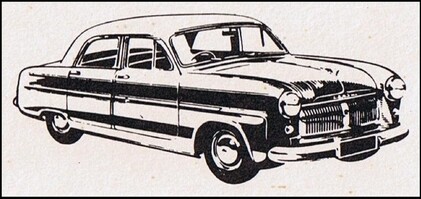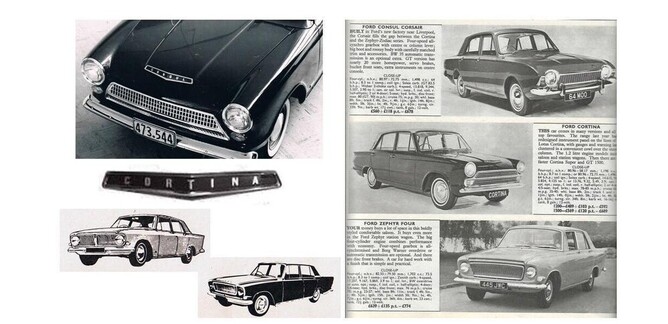Explaining the Ford Consul Nameplate
It is 1945. World War Two has just ended. Britain is the victor. But it doesn’t feel like it, because the cost of fighting the war has bankrupted the country. The United States steps in to loan Britain millions of dollars just to survive. Now Britain must repay that loan to the Americans.
The British government insisted that, when its industry was up and running again, they must export. This was especially so of the motor industry, which was offering high value products. New car design had, of course, been put on hold during the war years and so the first offerings from Britain, America and Europe was the pre-war models with a new paint job. The problem was made worse in Britain because the horsepower tax had restricted engine design - and overseas markets just didn't want them. Pages 106 to 109 of the Ford in New Zealand book “Driving Ahead” describes the challenges facing the motor companies at this time.
So in March, 1947 the British government repealed the horsepower tax laws. Now the manufacturers were free to design engines that could put out the power that overseas buyers wanted, and the race was on to be the first to hit the market with such a car. Ford of England turned to their parent in Detroit to draw up their first new post-war design, with exports in mind.
In April, 1947 Henry Ford died. Whilst the death of the company founder was sad, it left Henry Ford II free to advance the business. The first post-war car from Ford in America was the “Fortyniner” Ford Custom V8 (known as the “Single Spinner” in New Zealand and Australia). It was a revolutionary model, with slab sides giving it a modern, almost futuristic appearance. Under its skin Ford had finally dispensed with as much of Henry's old Ford technology as possible, but the side-valve engine remained.
The following year, Ford of England displayed their first postwar model, and it looked remarkably like a downsized “Fortyniner”. But it was even more advanced than the American car it was modeled upon! This was the Ford Consul (Ford of England designation EOTA), soon to be followed by its larger sister, the Ford Zephyr Six (EOTTA).
Gone from the Consul and Zephyr were side-valve engines – these cars had newly-designed overhead valve, oversquare motors, which ensured a lively performance out on the roads. Other features included unitary body construction, entirely new front suspension, hydraulic clutch and brake systems and centre-slung seating - five key points making the Consul and Zephyr Six the "Five Star Cars". They were truly revolutionary.
The Consul and the Zephyr were identical in construction from the firewall back, and most of the mechanical parts could be shared between the two. The six-cylinder Zephyr had a longer nose than the four-cylinder Consul, to accommodate the longer engine, and the grille treatment was different.
But there was nothing in common in the origin of the names for the two new models The Zephyr Six name was taken from Ford’s prewar Lincoln Zephyr V-12, and was chosen to exude excitement at a bleak time. The Consul title was a new creation – as the name suggests, these cars were to act as hard-working, loyal British consuls, representing Britain all over the world and and earning valuable foreign exchange in the process, to help repay the national debt. A massive 231,000 examples of the Mark One Consul were produced, and 175,000 Zephyrs (including its Zodiac derivative). It was a huge success story.
The first iteration of Consul (and Zephyr) was replaced in 1956 with the larger Mark Two versions (Consul shown above). Again the Consul front was shorter than the Zephyr 6 and, aside from detail changes, the two models were again identical from the firewall back. The capacity of their engines was increased, and, having a wider cabin, they were true six-seaters. In spite of their large seating capacity, the name Consul now became synonymous with the term "medium-sized car".
It doesn't just rain. Sometimes it pours...
About this time, the British car market was about to undergo another revolution, brought about by the advent of BMC's so-called Mini Minor. When the whispers about BMC's new mini car arrived at Ford, the Ford planners were already designing the Mark Three version of the Zephyr and Consul, for release in 1962 after the new Prefect in 1959, and Anglia in 1960-61. To answer the serious threat from BMC, Ford of Britain (as it was now known) put a hold the new Prefect and brought forward the new Anglia, being the smaller and lighter of the two, to compete against the Mini. The Mini and new Anglia (designated 105E) were both released in 1959 and, of course, the Anglia was powered by the all-new "Kent" overhead valve engine. It was a massive success - but the pressure on Ford of Britain now intensified further when word reached them that their own cousins at Ford of Germany, with support from Detroit, were planning their own light car for the European market, code-named "Cardinal". That was a threat to the job of the Consul - to earn still badly-needed foreign exchange for Britain.
Word also got out that BMC were planning a 4-door version of the Mini (which indeed would be released in 1962 as the 1100). Suddenly Ford of Britain realised they needed a much lighter model than that developed as the new Prefect! Indeed, they really had to go back to the drawing board and start all over - and there was no time to lose.
The all-new mid-size car model would have to meet Ford’s own strict new requirement for lightness, without sacrificing strength. Urgent work got under way to produce the new model, cheekily code-named “Archbishop”.
In the meantime, to carry matters over for Ford with a small four-door car, the life of the now very dated 100E Prefect was extended by transplanting into it the overhead valve 105E Anglia engine and a subtle facelift. Once that car was available to the market, the engineers dusted off the dies and moulds for the new Prefect in preparation for what would now be an interim model only. But, it doesn't just rain, it pours! For there was now another complication...
The next model Zephyr 6 and Consul, the Mark Three, was due for release in 1962. This time, the two models would share the same body, including the engine bay and bonnet. So, the new Mark Three Consul would not have a shorter front - a major departure from earlier marks - but Ford of Britain understood the demand for larger cars. Their thinking was that the new Prefect should adopt the Consul name, to signify "medium", and that name could also be used for the forthcoming "Archbishop". The Mark Three Consul - a large car - would become the Zephyr 4. Aside from the grill treatment, the bodies of the six and four-cylinder Zephyrs would be identical.
So, when the new Prefect was finally released for the 1961 model year, gone was the name Prefect. Instead this was the Consul Classic 315 (pictured below). The Consul had earned a reputation as a mid-size, solid and reliable car - and possibly Ford was reminding the market of those qualities when they added the suffix "Classic" name?
Meanwhile, all stops had been pulled in order to prioritise the "Archbishop". Given the crash program used to develop this all new car it is surprising how few blocks hindered its progress to production. With great fanfare, on 21 September, 1962 the “Archbishop” was given a simultaneous global release - but, being the first country to see a new day, New Zealand was the very first to see the exciting new car from Ford!
And the name? This was the Consul Cortina - a medium-sized car, with the other part of its moniker cheekily, again, taken from the Italian ski resort Cortina d'Ampezzo - the site of the highly successful 1956 Winter Olympics! But, as a good consul, it was again expected to represent Ford of Britain all over the world – and it would go on to do exactly that! Within two years the Consul prefix was forgotten - the new car was simply the Cortina, and Cortina would go on to be the most popular car ever built by Ford in Britain.
Above:
Top left is an early Cortina - the name across the bonnet is Consul; in the facelift for the 1965 model year, the bonnet name (inset) became Cortina.
Top right shows a Consul Corsair, which was released following the end of production of the Consul Classic 315. This would soon become known also simply as the Corsair.
The lower illustrations are of the Mark Three Zephyr - the four and six cylinder versions were now that same size, and the two were distinguished by different grille treatments.
Ford New Zealand did not import the Consul Corsair for local assembly, as there was simply not a place for it in our relatively small market, which was adequately served by the existing Ford range. However, a number did arrive in New Zealand as private imports and under the "No Remittance" scheme. (See pages 131 to 133 of the Ford in New Zealand "Driving Ahead" book for a full explanation of that scheme.)
Meanwhile, when the Consul prefix was dropped from the Corsair model name, the Consul title disappeared.
But, it did make a brief comeback in 1972....
That is when the Consul title was resurrected for the model that replaced the Mark Four iteration of the Zephyr and Zodiac range, possibly because that model's reputation had been so muddied by the problems that had plagued it. As had been the case with the Zephyr and Zodiac range two models, sharing the same body, were offered - the 2-litre Consul, and the plusher V6 Granada. But the Consul name only lived on in this model until 1975, when the lesser car also became known as Granada. The Consul name was now dead. Long live the Consul.
Note: Because of Britain's entry into the EEC, and New Zealand's closer economic ties with Australia - and not mentioning unfavourable exchange rates deeming British products uncompetitive - Ford New Zealand did not import the Granada and new Consul. Falcon and Cortina was all we needed.






